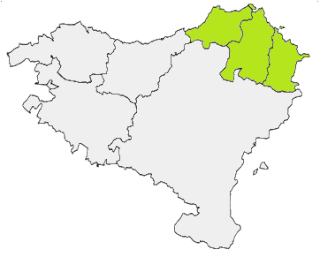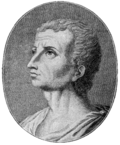
Aquitaine, archaic Guyenne or Guienne, is a historical region of Southwestern France and a former administrative region. Since 1 January 2016 it has been part of the administrative region of Nouvelle-Aquitaine. It is situated in the southwest corner of metropolitan France, along the Atlantic Ocean and the Pyrenees mountain range on the border with Spain; for most of its written history Bordeaux has been a vital port and administrative centre. It is composed of the five departments of Dordogne, Lot-et-Garonne, Pyrénées-Atlantiques, Landes and Gironde. Gallia Aquitania was established by the Romans in ancient times and in the Middle Ages, Aquitaine was a kingdom and a duchy, whose boundaries fluctuated considerably.

Gascony was a province of the southwestern Kingdom of France that succeeded the Duchy of Gascony (602–1453). From the 17th century until the French Revolution (1789–1799), it was part of the combined Province of Guyenne and Gascony. The region is vaguely defined, and the distinction between Guyenne and Gascony is unclear; by some they are seen to overlap, while others consider Gascony a part of Guyenne. Most definitions put Gascony east and south of Bordeaux.

The Kingdom of Navarre, originally the Kingdom of Pamplona, was a Basque kingdom that occupied lands on both sides of the western Pyrenees, with its northernmost areas originally reaching the Atlantic Ocean, between present-day Spain and France.

The Aquitani were a tribe that lived in the region between the Pyrenees, the Atlantic Ocean, and the Garonne, in present-day southwestern France in the 1st century BCE. The Romans dubbed this region Gallia Aquitania. Classical authors such as Julius Caesar and Strabo clearly distinguish the Aquitani from the other peoples of Gaul, and note their similarity to others in the Iberian Peninsula.

The Aquitanian language was the language of the ancient Aquitani, spoken on both sides of the western Pyrenees in ancient Aquitaine and in the areas south of the Pyrenees in the valleys of the Basque Country before the Roman conquest. It probably survived in Aquitania north of the Pyrenees until the Early Middle Ages.

The French Basque Country, or Northern Basque Country, is a region lying on the west of the French department of the Pyrénées-Atlantiques. Since 1 January 2017, it constitutes the Basque Municipal Community presided over by Jean-René Etchegaray.
The origin of the Basques and the Basque language is a controversial topic that has given rise to numerous hypotheses. Modern Basque, a descendant or close relative of Aquitanian and Proto-Basque, is the only pre-Indo-European language that is extant in western Europe. The Basques have therefore long been supposed to be a remnant of a pre-Indo-European population of Europe.

The Varduli were a pre-Roman tribe settled in the north of the Iberian Peninsula, in what today is the western region of the Basque Country.

The Caristii were a pre-Roman tribe settled in the north of the Iberian Peninsula, in what today are known as the historical territories of Biscay and Álava, in the Basque Country, northern Spain.

The Autrigones were a pre-Roman tribe that settled in the north of the Iberian Peninsula, in what today is the western Basque Country and northern Burgos and the East of Cantabria, Spain. Their territory limited with the Cantabri territory at west, the Caristii at east, the Berones at the southeast and the Turmodigi at the south. It is discussed whether the Autrigones were Celts, theory supported by the existence of toponyms of Celtic origin, such as Uxama Barca and other with -briga endings and that eventually underwent a Basquisation along with other neighboring tribes such as the Caristii and Varduli.

Oiasso, Oiasona or Oiarso was a Vascon Roman (Civitas) town located on the left bank of the Bidasoa estuary in the Bay of Biscay. Archaeological evidence unearthed recently pinpoints the core area of Oiasso in the old quarter of Irun (Gipuzkoa) by the Spanish-French border, where harbour and bath remains have been discovered. However, two other focuses in Cape Higuer and hermitage Ama Xantalen point to a wider complex outside the main nucleus.

The Duchy of Gascony or Duchy of Vasconia was a duchy located in present-day southwestern France and northeastern Spain, an area encompassing the modern region of Gascony. The Duchy of Gascony, then known as Wasconia, was originally a Frankish march formed to hold sway over the Basques. However, the duchy went through different periods, from its early years with its distinctively Basque element to the merger in personal union with the Duchy of Aquitaine to the later period as a dependency of the Plantagenet kings of England.

Novempopulania was one of the provinces created by Diocletian out of Gallia Aquitania, which was also called Aquitania Tertia.

The Basques are an indigenous ethno-linguistic group mainly inhabiting the Basque Country. Their history is therefore interconnected with Spanish and French history and also with the history of many other past and present countries, particularly in Europe and the Americas, where a large number of their descendants keep attached to their roots, clustering around Basque clubs which are centers for Basque people.
Semen /ʂemen/ or Xemen /ʃemen/ is a medieval Basque given name of the Vasconic area. It is based on the Basque root seme < senbe 'son' as found in the ancient Aquitanian name Sembetten, attested form "sehi" as 'child', hypothetical ancient root *seni. The explanation by the Biblical name Šim’ōn (Simon) is less convincing. Some think the name may be a corruption of the later part of the Latin name Ma-ximinus, as there are late Classic records that various individuals with this name were becoming very active as officials and residents in upper Hispania near the Pyrenees and Tarraconensis during the last century of the Western Roman Empire, and perhaps into the period of transition from imperial province to independent Kingdom during Visigothic rule.

The paleo-Hispanic languages are the languages of the Pre-Roman peoples of the Iberian Peninsula, excluding languages of foreign colonies, such as Greek in Emporion and Phoenician in Qart Hadast. After the Roman conquest of Hispania the Paleohispanic languages, with the exception of Proto-Basque, were replaced by Latin, the ancestor of the modern Iberian Romance languages.
Late Basquisation is a minority hypothesis that dates the arrival of the first speakers of the Basque language in northeastern Iberia from Aquitaine to the 5th or 6th century AD – as opposed to the mainstream view of it being the last remaining descendant of one of the pre-Indo-European languages of Prehistoric Europe.
Proto-Basque, or Pre-Basque, is the reconstructed predecessor of the Basque language before the Roman conquests in the Western Pyrenees. A small sample of what is thought to be a form of Proto-Basque has been discovered on the Hand of Irulegi, an inscribed bronze artifact in the shape of a right hand dated to the 1st century BCE.

The Vasconic languages are a putative family of languages that includes Basque and the extinct Aquitanian language. The extinct Iberian language is sometimes tentatively included.



















